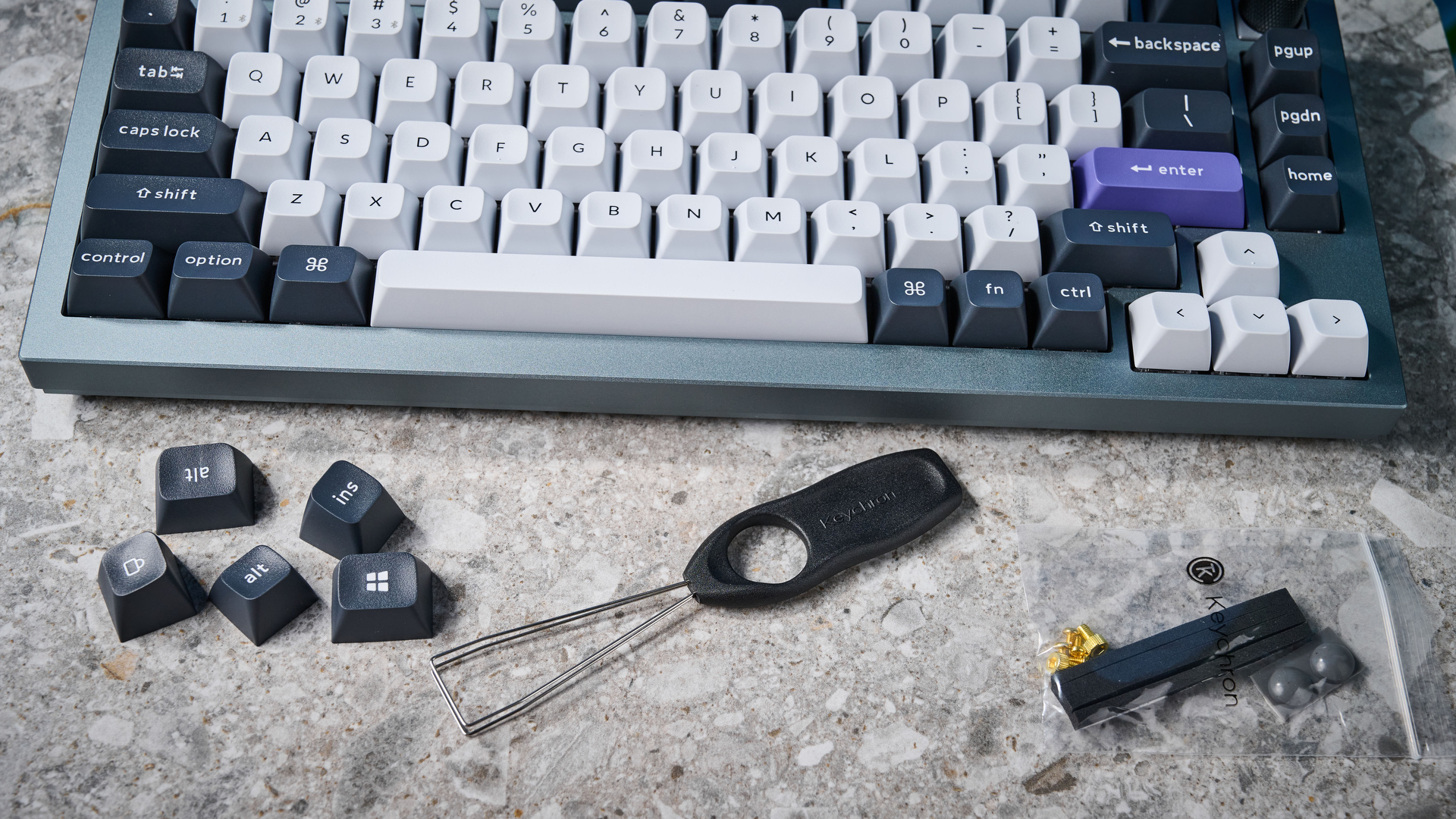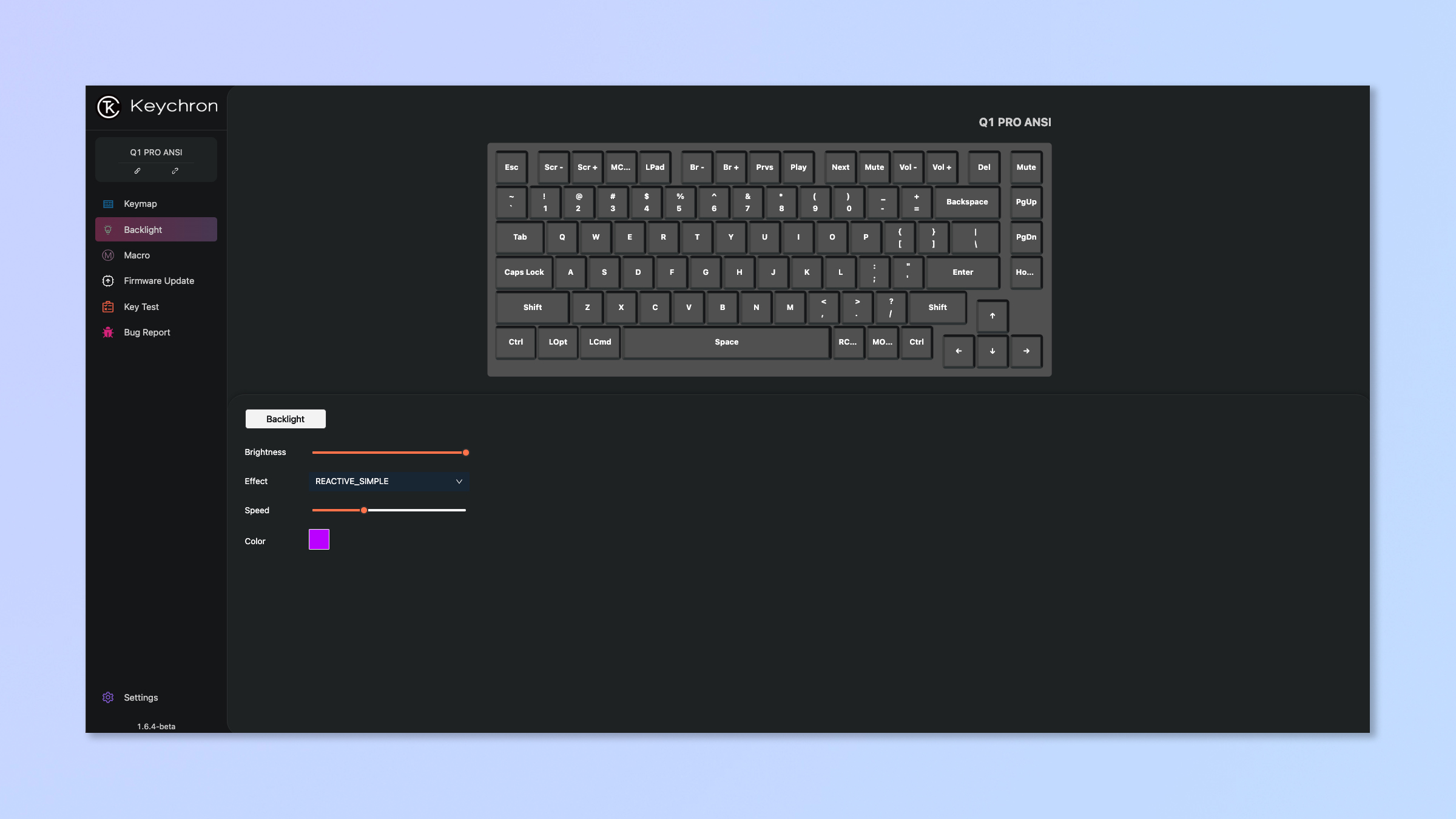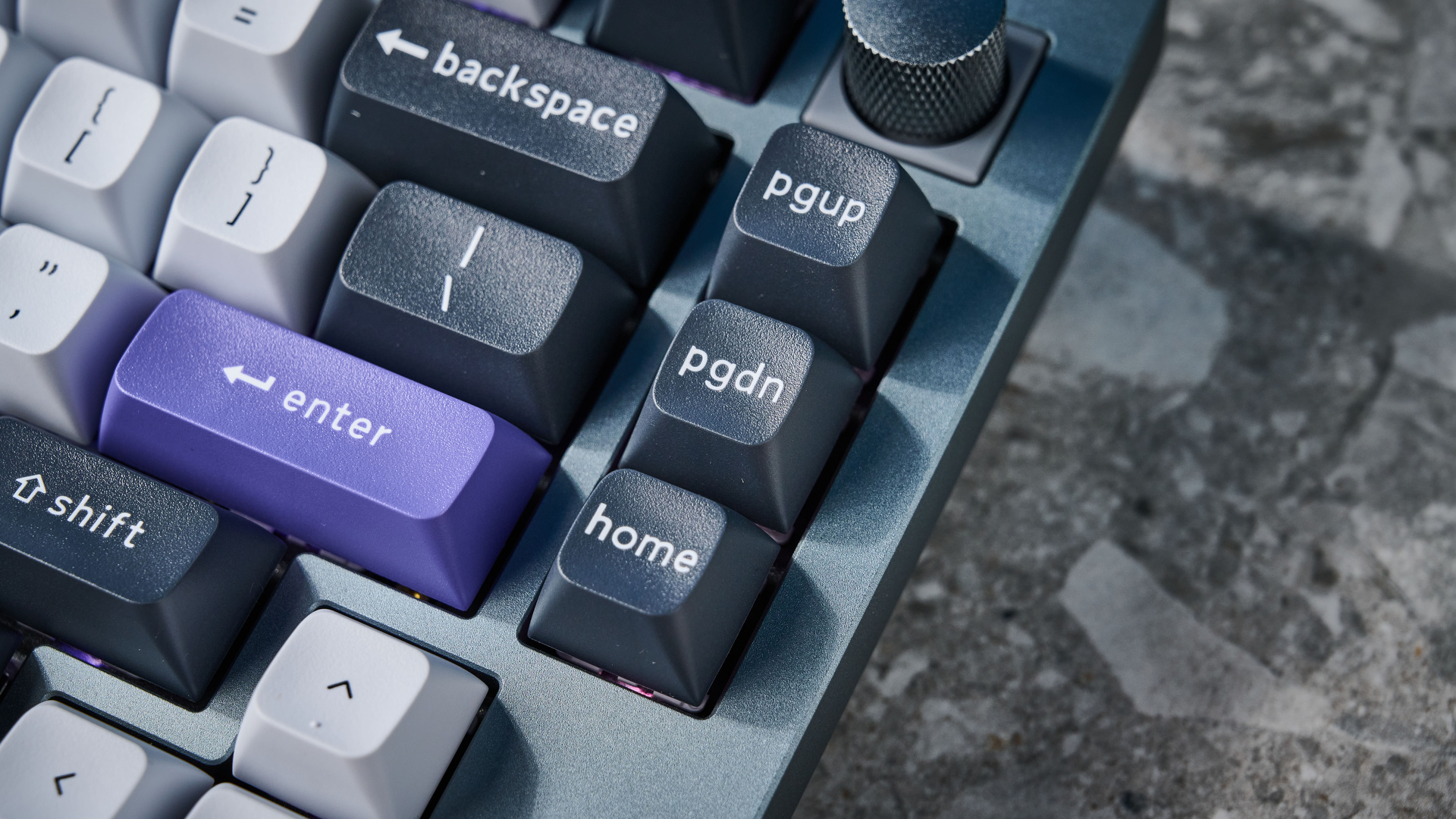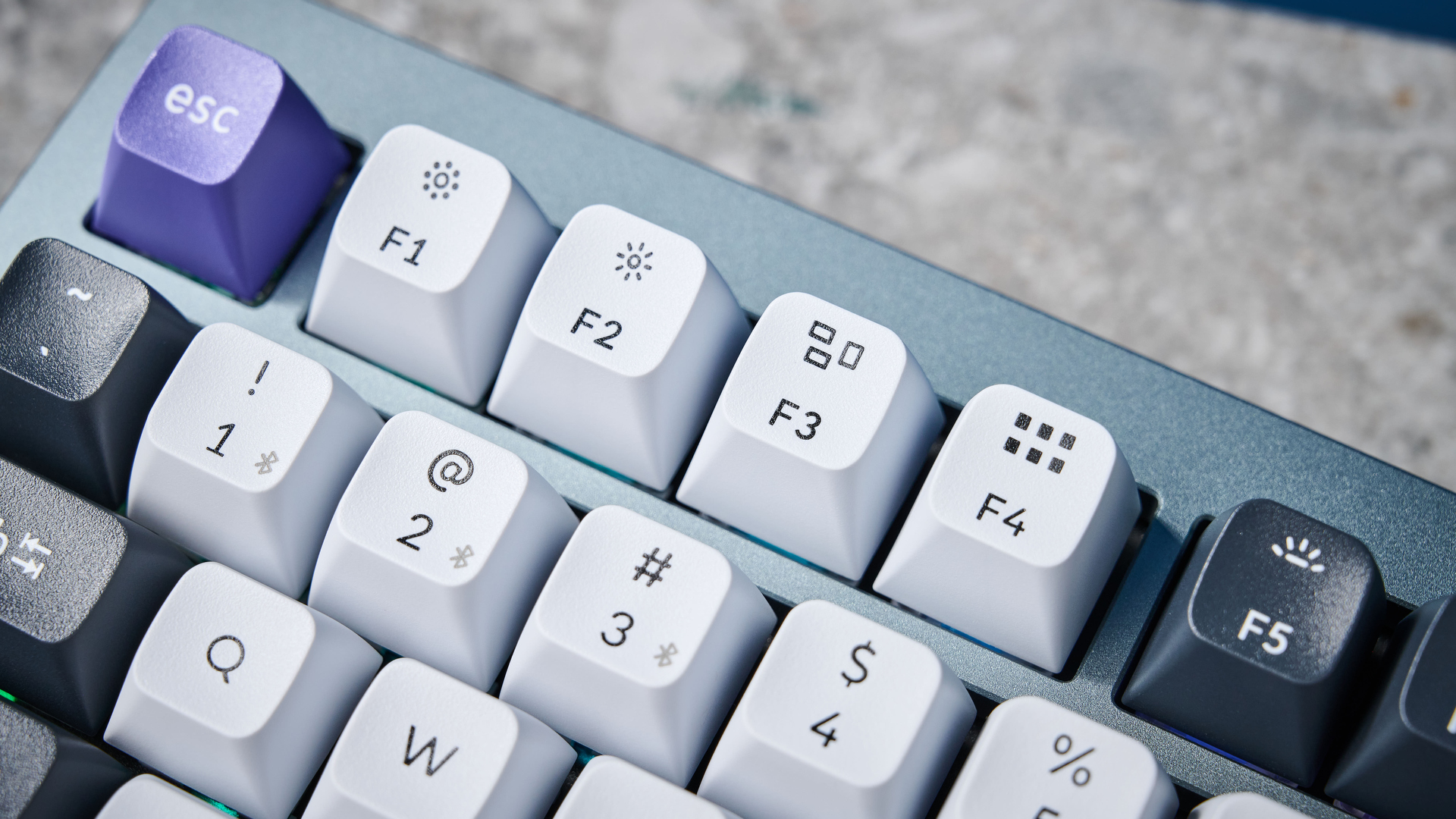Tom's Guide Verdict
As comfortable as mechanical keyboards get. The Keychron Q1 Pro looks gorgeous and feels it too thanks to a bouncy plate and KSA profile keycaps. It sounds decent stock, but is hot swappable and runs QMK firmware, opening up lots of customization potential. Like most of Keychron’s metal boards, the Q1 Pro doubles as an anvil, so isn’t one to carry around despite its compact 75% layout. Oh, and you’ll need a pretty penny spare to get hold of one.
Pros
- +
Lovely, bouncy typing
- +
Built well
- +
Great sound
- +
Gorgeous styling
- +
QMK Firmware
Cons
- -
Expensive
- -
Heavy
Why you can trust Tom's Guide
The Keychron Q1 Pro is a metal-clad, 75% wireless productivity keyboard that, at first glance, closely resembles Keychron’s other models in the same category. It’s a rectangular chunk of aluminum with cutesy rounded keycaps, Gateron switches, 1,000Hz polling and a 4,000mAh battery. Same old, same old — except, it isn’t.
While the Q-Pro series shares much of its DNA with Keychron’s Q and Q-Max lines, the Q-Pro boards boast a few nifty changes that separate them from the pack. They’re easy to overlook, but do make a big difference to how Q-Pro boards feel during typing. And that’s the kicker: the Keychron Q1 Pro is built for comfort, especially for those who type extensively, like when writing detailed product reviews multiple times a week.
However, as I find myself saying more and more about Keychron boards these days: all of this doesn't come cheap. The Q1 Pro will set you back an imposing $199. So, is it worth it? Is this one of the best mechanical keyboards around? Find out in my full Keychron Q1 Pro review.
Keychron Q1 Pro review: Cheat sheet
- What is it? A metal-cased 75% custom mechanical keyboard from Keychron
- Who is it for? Productivity users who want a comfortable keyboard for long typing stints
- What does it cost? $219 at Amazon, so it’s rather pricey
- What’s good? Almost everything: build, styling, type-feel, comfort
- What’s not? It’s hella pricey and rather heavy for a 75%, although it isn’t intended to be portable
Keychron Q1 Pro review: Specs
| Price | $219 / £211 |
| Switches | Keychron K Pro |
| Layout | 75%, 81-key |
| Mount type | Gasket |
| Keycap material | Double-shot PBT |
| Keycap profile | KSA |
| Case material | Aluminum |
| OS' supported | Windows, macOS, iOS, iPadOS, Android |
| Connectivity | Wired, 2.4G, Bluetooth |
| Polling rate | 1,000Hz (wired); 90Hz (wireless) |
| Battery | 4,000mAh |
| Measurements | 12.8 x 5.7 x 1.4 inches |
| Weight | 3.8 lbs |
Keychron Q1 Pro review: The ups
This is one for the typists — delivering bouncy, comfortable typing with smooth switches and lovely KSA profile keycaps. In trademark Keychron style, it’s built well and brings plenty of premium features including QMK firmware and a 4,000mAh battery.
Comfortable, bouncy typing

As I mentioned earlier, the Q1 Pro is a typist’s keyboard through and through, prioritizing a comfortable type-feel above all and boasting a slew of features to make life easier for those who hit the keys (like myself). Its double-shot PBT keycaps host deep concave centers to help you find and to increase type comfort.
The caps utilize Keychron’s own KSA shape profile, which rakes steeply outward from the center of the board, and allows fast access to letters while demanding less stretch to fully decompress keys at the extremities. KSA is a very high profile and has taken some getting used to. After acclimatizing, though, it’s a perfectly comfortable profile to use over long periods.

The Q1 Pro uses a flexible polycarbonate (PC) plate to better absorb the impact of bottomed-out keystrokes, increasing comfort over the ultra-firm metal plates in the Q series. Likewise, only two layers of internal sound and impact damping are employed instead of the six layers elsewhere in Q-series boards like the Keychron Q3 Max ($214).
Combined with the flexible PC plate and soft gasket mounts, this gives the PCB assembly more room to move inside the case, resulting in a softer, springier feel, especially when bottoming-out — again aiding comfort. This design causes the keys to bounce slightly as you type, like firm jello, but the comfortable typing feel makes up for it. Keychron also added dense sound-absorbing foam to keep noise levels steady despite the lighter insulation.
A deft balance

Type testing the Q1 Pro on 10fastfingers.com, my speed was higher than average at 99 words per minute, while my accuracy was around 5 percentage points lower than average.
The higher KSA profile caused me more mistypes than shorter profiles like the NuPhy Halo75 V2’s ($129) mSA profile, or the Keychron K2 HE’s ($140) OSA profile.
| Keyboard | Words per minute (WPM) | Typing accuracy |
|---|---|---|
| Keychron Q1 Pro | 99 | 82.91% |
| Keychron K2 HE | 106 | 93.97% |
| Keychron Q3 Max | 94 | 81.80% |
| NuPhy Halo75 V2 | 90 | 88.21% |
| NuPhy Gem80 | 96 | 92.82% |
| Lofree Flow84 | 96 | 87.55% |
| Pete's rolling averages (all keyboards) | 93.00 | 87.73% |
Likewise, to maximize accuracy, I’d recommend a magnetic board like the K2 HE or Keychron Q1 HE, which allow you to crank up the actuation dead zone to further reduce mistypes. Again, though, the Q1 Pro board is about striking a balance between comfort, accuracy and speed, which it manages deftly.
On offer switch-wise are Gateron K Pro pre-lubed switches in either Red (linear), Brown (tactile) or Banana (tactile) guise. I tested the linears, which are smooth and relatively easy to actuate at 45g force required, suiting the lightweight bouncy character of the board.
If you love a tactile feel, I recommend the banana switches. They have an early bump, short spring, shorter travel, and a deeper sound. You’ll have little issue typing on any of these switches, it simply comes down to preference.
Built, and built well

The Q1 Pro is built like a tungsten Arnie sculpture, which is par for the course with Keychron’s boards (especially the metal-clad Q-series). It’s put together wonderfully, with the aforementioned double-shot PBT keycaps, aluminum top and bottom cases and screw-in stabilizers to keep larger keys stable.
The board isn’t bad looking either. The Q1 Pro sticks to Keychron’s classic, timeless look — nothing flashy, but it works. It’s not a head-turner, but I’d give it a solid 7.

Keychron offers the board in several colorways. I tested the Space Gray case, with its black, white and purple keycaps, but you can also grab the Q1 Pro in black with blue accents or white with gray and red accents. Special editions also come in solid black or white. They all look great, each in turn demonstrating Keychron’s habitual modest charm.
(Mostly) refined ‘clack’
As with Keychron’s Q-Max series, the Q-Pro series utilizes a polycarbonate (PC) plate, which results in a light plasticky ‘clack’ sound with the linear K Pro switches. I much prefer this to the metallic clack of the Q series, with its aluminum plate.

As I mentioned earlier, the Q-Pro line loses several layers of internal insulation versus Q-Max boards, resulting in a slightly more hollow sound than the Q3 Max’s curt, echoless tap. There are also the odd metallic pings from letter keys, which can be quite loud. As a motorcyclist with sensitive ears — and currently dealing with an ear infection — the high-pitched pinging of the Q1 Pro has been uncomfortable while I write this review, and I’m only 1,000 words in.
Nevertheless, thanks to its sturdy case, heavy PBT caps and thicker sound absorbing layers, the Q1 Pro still sounds pretty nice, and with the K Pro linear switches the board remains just about quiet enough for busy office use. If you’d like a louder, thockier sound, opt for the K Pro Banana switches.
One for the modders

The Keychron Q1 Pro is hot-swappable, meaning you can remove the factory switches without needing to desolder them from the PCB. It also comes with the tools required to open it up and mess with the internals, with a few spare gasket mounts chucked in.
To reduce the bounce slightly, I fitted the Q1 Pro with an extra layer of gasket mounts, although Keychron is rather mean with what it supplies and there weren’t enough in the box to go round, forcing me to steal some from another of our test boards.

Similarly-priced modding boards from NuPhy like the Gem80 and Nos75 put Keychron to shame here, coming bundled with lots more components to tweak type feel. This includes full sets of gaskets, strips, and seals in different firmness levels, offering more control over the typing feel right out of the box.
The Q1 Pro runs open source QMK firmware, as is now the default for Keychron boards, opening up a wide range of software customization and control via the excellent Keychron Launcher web app. Change lighting, remap keys, set macros: it’s all easy as pie.
It’s fast enough

While Keychron is moving ever further into hybrid gaming and productivity keyboards with its Hall Effect range, its mechanical boards are still perfectly capable for gaming providing you don’t need the bells and whistles of magnetic switches.
The Q1 Pro polls at 1,000Hz over wired, which is plenty fast enough for virtually every gamer who has ever existed. Over wireless, polling drops to 90Hz, which could cause noticeable latency.
Several weeks’ use

Making a return in the Q1 Pro is Keychron’s ubiquitous 4,000mAh battery, which I’ve covered many times in my keyboard reviews. It’s a solid performer and, in my opinion, sets the benchmark for wireless RGB keyboards. On the Q1 Pro, you can expect a good two to three weeks from a single charge, although duration will naturally vary based on usage, RGB pattern and brightness.
Keychron Q1 Pro review: The downs
The Keychron Q1 Pro’s flaws are few, and boil down to price and weight. If you can stomach the former, the latter needn’t be too much of a concern (emphasis on “if”).
It ain’t cheap

There isn’t much to say really — the Q1 Pro is just bloody expensive at $219 assembled or $179 barebones from Keychron. Ludicrous as it may sound, it isn’t priced outlandishly for its arena — that is to say, premium and highly-moddable custom keyboards. The Keychron Q3 Max will set you back $214, as will the Lemokey X4. NuPhy asks $223 for the NuPhy Nos75 and $199 for the NuPhy Gem80, fully assembled. Useful context, yes, but none of that makes the Q1 Pro cheap.
Is it worth it? If you’re a serious modder or you type more than 8,000 words a week, I’d say yes. Otherwise, I’d advise you save $60 and buy a Keychron K2 HE Special Edition, especially if you moonlight as a gamer.
But ain’t it heavy

As with most of Keychron’s metal boards, the Q1 Pro is destined to be either an anvil or a desk ornament, and won’t be much use to anyone who requires otherwise. On top of its 3.8 lbs kerb weight, it isn't exactly sleek-of-profile either, so doesn’t stash well in a bag — a fact I am all too familiar with after having karted it back from the office.
If you’re after something portable to use on or ease your commute, then you my friend are barking up the wrong tree. Ye commuters, look instead at a low profile keyboard like the Lofree Flow84 ($169), the NuPhy Air75 V2 ($119) or the Keychron K13 Max ($94).
Keychron Q1 Pro review: Verdict

Products must, at least in large part, be judged against their intended purpose: what did the designers go out to create? With the Q1 Pro, Keychron intended to produce a keyboard for heavy (dare I say “pro”) typists that would excel in regards to comfort. The formula tweaks it made to do so may seem subtle, but small changes can make a big difference, as is demonstrated by the Q1 Pro.
Pared back internal insulation and a flexible PC plate allow the board to bear happily the brunt of bottoming-out keycaps. The tall KSA profile, while not the most accurate, is extremely comfortable in use. Gateron’s K Pro switches, although far from adventurous, are consummate and smooth.
This is a board on which to smash out hundreds and thousands of words, then hundreds of thousands more. Before you buy it though, just check whether you can expense it instead.

Peter is a Senior Editor at Tom's Guide, heading up the site's Reviews team and Cameras section. As a writer, he covers topics including tech, photography, gaming, hardware, motoring and food & drink. Outside of work, he's an avid photographer, specialising in architectural and portrait photography. When he's not snapping away on his beloved Fujifilm camera, he can usually be found telling everyone about his greyhounds, riding his motorcycle, squeezing as many FPS as possible out of PC games, and perfecting his espresso shots.

